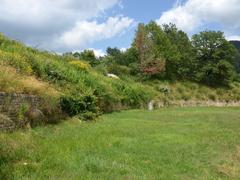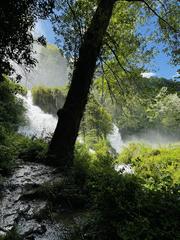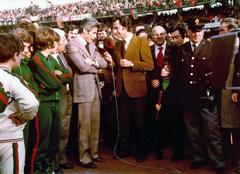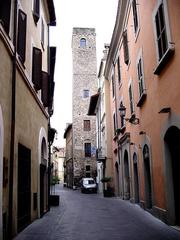Caos Museum Of Contemporary And Modern Art 'Aurelio De Felice'
Visiting the CAOS Museum of Contemporary and Modern Art “Aurelio De Felice” – Terni, Italy
Date: 14/06/2025
Introduction: A Fusion of Industrial Heritage and Artistic Vitality
In the heart of Terni, Umbria, the CAOS Museum of Contemporary and Modern Art “Aurelio De Felice” is an exemplary testament to the city’s transformation from an industrial hub to a vibrant center of culture and creativity. Housed within the historic CAOS complex—once the SIRI chemical factory—the museum preserves the raw architectural character of its industrial past, blending exposed brickwork and steel beams with dynamic exhibitions of modern and contemporary art. This unique venue not only honors the legacy of Aurelio De Felice, a renowned local sculptor, but also integrates multidisciplinary institutions, including the Museo Archeologico “Claudia Giontella,” the Museo Paleontologico, and the Teatro Secci. Together, they create an environment where art, history, and community intersect.
This comprehensive guide explores the museum’s origins, cultural significance, visitor information, accessibility, and nearby attractions. Whether you are passionate about art, interested in urban history, or seeking to experience Terni’s unique identity, the CAOS complex offers an immersive and inspiring destination. For the latest updates, consult the official CAOS Museum website and local tourism resources (CAOS Museum, Italy Segreta, Comune di Terni).
Contents
- Introduction
- Industrial Roots and Site Transformation
- Establishment of the CAOS Complex
- The Role and Collections of the “Aurelio De Felice” Museum
- Cultural Impact and Ongoing Evolution
- Visitor Information: Hours, Tickets, and Accessibility
- Nearby Attractions and Travel Tips
- Frequently Asked Questions (FAQ)
- Sources and Further Reading
Industrial Roots and Site Transformation
From Factory to Cultural Landmark
The CAOS Museum occupies the former SIRI chemical plant, a defining feature of Terni’s rapid industrialization in the early 20th century. During its heyday, the SIRI factory symbolized technological progress and economic strength, earning Terni the nickname “Italian Manchester” (Italy Segreta). Built in the 1920s, the factory contributed to the city’s urban development and prosperity.
By the late 20th century, however, Terni’s industrial sector declined due to global market shifts and environmental challenges. The SIRI plant eventually closed, leaving behind significant but derelict industrial architecture. The site became central to conversations about urban renewal, representing both the city’s past hardships and its potential for cultural rebirth.
Vision for Regeneration
Recognizing the site’s potential, local authorities and cultural leaders launched a project to convert the abandoned factory into a multidisciplinary cultural hub. The renovation respected the principles of industrial archaeology by retaining the building’s original features—exposed brick, robust steel framework, and open spaces—while adapting the interiors for museums, galleries, and performance venues (Italy Segreta).
Establishment of the CAOS Complex
The CAOS complex (Centro Arti Opificio Siri) officially opened in the early 21st century, marking a significant milestone in Terni’s cultural reinvention. Spanning over 5,000 square meters, the complex hosts:
- Museo d’Arte Moderna e Contemporanea “Aurelio De Felice”: Showcasing modern and contemporary art, with a focus on local and national artists.
- Museo Archeologico “Claudia Giontella”: Highlighting the region’s archaeological heritage.
- Museo Paleontologico: Featuring paleontological discoveries from Umbria.
- Teatro Secci: A modern theater for performances and events.
- Baravai Anfiteatro Romano: An open-air venue for concerts and festivals (CAOS Museum).
This adaptive reuse of industrial infrastructure is celebrated as a model for sustainable urban regeneration.
The Role and Collections of the “Aurelio De Felice” Museum
Honoring a Local Master
Central to the CAOS complex is the Museo d’Arte Moderna e Contemporanea “Aurelio De Felice.” Named after the acclaimed sculptor from Terni, the museum’s collection is rooted in De Felice’s own works and vision, enriched by his donations and ongoing support for contemporary art. Key highlights include:
- Aurelio De Felice’s “Adolescente con ocarina”
- Gino Severini’s “Danseuse” (representing Italian Futurism)
- Works by Orneore Metelli and other notable Italian artists
The museum balances tradition and innovation, presenting international masters alongside emerging talents and hosting rotating exhibitions that address both local and global themes (CAOS Museum).
A Dialogue of Art and Architecture
Housed in a former industrial space, the museum’s architecture creates a compelling context for contemporary art. The interplay between industrial remnants and artistic expression invites visitors to reflect on the relationship between past and present.
Cultural Impact and Ongoing Evolution
Revitalizing Terni’s Urban Identity
The CAOS complex has revitalized a previously neglected area of Terni, transforming it into a lively cultural gathering place. It preserves the city’s industrial memory while providing innovative programming—exhibitions, performances, and educational workshops—for diverse audiences (Terni Life). Notable projects like Silvia Piconi’s “Segni di Memoria” explore the intersection of art, memory, and urban transformation (Terni Today).
Community Engagement and Partnerships
The CAOS Museum fosters community participation through collaborations with schools, universities, and local organizations. Its programming—spanning exhibitions, guided tours, and workshops—ensures accessibility and inclusivity, making the arts available to all. Strategic partnerships with academic and cultural institutions further enhance its reach and impact (Comune di Terni).
Visitor Information: Hours, Tickets, and Accessibility
- Location: Via Francesco Molè, 25, Terni, Italy (CAOS Museum)
- Opening Hours: Thursday to Sunday, 10:00–13:00 and 16:00–19:00
- Tickets: Admission is affordable, with discounts for students, families, and residents. Some events and exhibitions may require online booking.
- Guided Tours: Available by reservation and recommended for deeper insights into the collections and history.
- Accessibility: The complex is wheelchair accessible, with elevators, ramps, and accessible restrooms. Guide dogs are welcome. Some areas may require staff assistance.
- Facilities: Café/restaurant (FAT), bookshop, conference rooms, and educational spaces offer comfort and convenience (Umbria Tourism).
- Getting There: The museum is centrally located, accessible by bus, train (10 minutes from Terni station), taxi, or car (parking available nearby).
Nearby Attractions and Travel Tips
- Museo Archeologico “Claudia Giontella”: Explore Terni’s ancient history.
- Roman Amphitheatre & Cathedral of Terni: Visit these historic landmarks.
- Ponte Carducci and Nera River Walks: Enjoy scenic strolls near the museum.
- Dining and Accommodation: Numerous options along Via Cavour, Via Garibaldi, and Viale Campofregoso.
Travel Tip: Plan your visit in spring or fall for pleasant weather and cultural festivals. Combine your museum tour with other local attractions for a full cultural itinerary.
Frequently Asked Questions (FAQ)
Q: What are the CAOS Museum’s visiting hours?
A: Thursday to Sunday, 10:00–13:00 and 16:00–19:00.
Q: How do I buy tickets?
A: On-site or online via the official website.
Q: Is the museum accessible?
A: Yes, most areas are wheelchair accessible. Guide dogs are allowed.
Q: Are guided tours available?
A: Yes, by prior arrangement.
Q: What other sites are nearby?
A: Museo Archeologico “Claudia Giontella,” Roman Amphitheatre, Cathedral of Terni, Ponte Carducci, and the Nera River.
Sources and Further Reading
- Italy Segreta – Terni: Between Nature and Steel
- CAOS Museum: Official Website – Calendar and Activities
- Comune di Terni – CAOS Cultural Center
- Umbria Tourism – CAOS Modern and Contemporary Art Museum
- Terni Life – CAOS Events
Final Tips
The CAOS Museum of Contemporary and Modern Art “Aurelio De Felice” stands as a beacon of cultural renewal in Terni, offering visitors a rich blend of history, art, and community engagement. Its accessible facilities, diverse programming, and central location make it a must-see for anyone exploring Umbria. For a seamless visit, check official updates for current exhibitions, health measures, and event schedules.
Download the Audiala app for personalized tips and updates, and follow the museum on social channels for the latest news in Terni’s dynamic cultural landscape.



